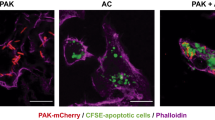Abstract
The present study evaluated whether macrophage activation would reduce the depression in the capacity of macrophages to produce H2O2 following EIgG phagocytosis. Macrophage activation was accomplished by exposing inflammatory rat peritoneal macrophages to 10 units of IFNγ for 72 h. IFNγ treatment caused a four to fivefold increase in phorbol myristate acetate (PMA)-triggered H2O2 production, but Fc receptor phagocytic function was unaltered. IFNγ-activated macrophages were able to phagocytize a greater number of EIgG before a decrease in PMAtriggered H2O2 production was observed and the level of H2O2 production did not fall below that of untreated-inflammatory macrophages that had not received an EIgG phagocytic challenge. The depression in Fc receptor phagocytic function was unaltered with macrophage activation. These results indicate that activated macrophages are resistant to the depression of respiratory burst capacity caused by erythrocyte phagocytosis and suggests that IFNγ treatment may be effective in preventing the impairment of host defense against bacterial infection that is associated with erythrocyte phagocytosis.
Similar content being viewed by others
References
Loegering, D. J. 1986. Kupffer cell complement receptor clearance function and host defense.Circ. Shock. 20:321.
Loegering, D. J., L. M. Commins, F. L. Minnear, L. A. Gary, andL. A. Hill. 1987. Effect of kupffer cell phagocytosis of erythrocytes and erythrocyte ghosts on susceptibility to endotoxemia and bacteremia.Infect. Immun. 55:2074.
Commins, L. M., D. J. Loegering, andP. W. Gudewicz. 1990. Effect of phagocytosis of erythrocytes and erythrocyte ghosts on macrophage phagocytic function and hydrogen peroxide production.Inflammation 14:705.
Hand, W. L., andN. L. King-Thompson. 1983. Effect of erythrocyte ingestion on macrophage antibacterial function.Infect. Immun. 40:917.
Stewart, L. S., J. Liceaga, andJ. H. Brock. 1988. Inhibition of hydrogen peroxide release from activated macrophages by prior ingestion of erythrocytes or haemoglobin.FEMS Microbiol. Immunol. 1:27.
Adams, D. O., andT. A. Hamilton. 1984. The cell biology of macrophage activation.Annu. Rev. Immunol. 2:283.
Dijkmans, R., andA. Billiau. 1988. Interferonγ: A master key in the immune system.Curr. Opin. Immunol. 1:269.
Ralph, P., I. Nakoinz, andD. Rennick. 1988. Role of interleukin 2, interleukin 4, and alpha, beta, and gamma interferon in stimulating macrophage antibody-dependent turmoricidal activity.J. Exp. Med. 167:712.
Nathan, C. F., H. W. Murray, M. E. Wiebe, andB. Y. Rubin. 1983. Identification of interferon-gamma as the lymphokine that activates human macrophage oxidative metabolism and antimicrobial activity.J. Exp. Med. 158:670.
Garotta, G., K. W. Talmadge, J. R. L. Pink, B. Dewald, andM. Baggiolini. 1986. Functional antagonism between type I and type II interferons on human macrophages.Biochem. Biophys. Res. Commun. 140:948.
Murray, H. W., B. Y. Rubin, andC. D. Rothermel. 1983. Killing of intracellularLeishmania donovani by lymphokine-stimulated human mononuclear phagocytes. Evidence that interferon-gamma is the activating lymphokine.J. Clin. Invest. 72:1506.
Murray, H. W., G. I. Byrne, C. D. Rothermel, andD. M. Cartelli. 1983. Lymphokine enhances oxygen-dependent activity against pathogens.J. Exp. Med. 158:234.
Schreiber, R. D. 1984. Identification of gamma-interferon as a murine macrophage-activating factor for tumor cytotoxicity.Contemp. Top. Immunobiol. 13:171.
Talmadge, K. W., H. Gallati, F. Sinigaglia, A. Walz, andG. Garotta. 1986. Identity between human interferon-gamma and “macrophage activating factor” produced by human T lymphocytes.Eur. J. Immunol. 16:1471.
Bukholm, H., B. P. Berdel, C. Haug, andM. Degre. 1984. Mouse fibroblast interferon modifiesSalmonella typhimurium infection in infant mice.Infect. Immun. 45:62.
Gould, C. L., andG. Sonnenfeld. 1987. Effect of treatment of mice with interferon-γ and concanavalin-A on the course of infection of mice withSalmonella typhimurium strain LT-2.J. Interferon Res. 7:255.
Hershman, M. J., H. C. Polk Jr., J. D. Pietsch, R. E. Shields, S. R. Wellhausen, andG. Sonnenfeld. 1988. Modulation of infection by gamma interferon treatment following trauma.Infect. Immun. 56:2412.
Mellors, J. W., R. J. Debs, andJ. L. Ryan. 1989. Incorporation of recombinant gamma interferon into liposomes enhances its ability to induce peritoneal macrophage antitoxoplasma activity.Infect. Immun. 57:132.
Murray, H. W. 1988. Interferon-gamma, the activated macrophage, and host defense against microbial challenge.Ann. Intern. Med. 108:595.
Watanabe, K., K. Kagaya, T. Yamada, andY. Fukazawa. 1991. Mechanism for candidacidal activity in macrophages activated by recombinant gamma interferon.Infect. Immun. 59:521.
Ruch, W. P., P. H. Cooper, andM. Baggiolino. 1983. Assay of H2O2 production by macrophages and neutrophils with homovanillic acid and horseradish peroxidase.J. Immunol. Methods 63:347.
Labarca, C., andK. Paigen. 1980. A simple, rapid, and sensitive DNA assay procedure.Anal. Biochem. 102:344.
Nathan, C. F., andS. Tsunawaki. 1986. Secretion of toxic oxygen products by macrophages: regulatory cytokines and their effect on the oxidase.In Biochemistry of Macrophages. Ciba foundation Symposium 118. Pitman, London, 211–230.
Leu, R. W., J. A. Rummage, andM. J. Horn. 1989. Characterization of murine macrophage Fc receptor-dependent phagocytosis and antibody-dependent cellular cytotoxicity during in-vitro culture with interferon-gamma, alpha/beta, and/or fetal bovine serum.Immunobiology 178:340.
Guyre, P. M., P. M. Morganelli, andR. Miller. 1983. Recombinant immune interferon increases immunoglobulin G Fc receptors.J. Clin. Invest. 72:393.
Warren, M. K., andS. N. Vogel. 1985. Bone marrow-derived macrophages: Development and regulation of differentiation markers by colony-stimulating factor and interferons.J. Immunol. 134:982.
Schwacha, M. G., D. L. Loegering, L. M. Commins, andP. W. Gudewicz. 1991. Scavengers of reactive oxygen intermediates do not mediate the depression of macrophage hydrogen peroxide production caused by erythrocyte phagocytosis.Inflammation 15:447.
Author information
Authors and Affiliations
Rights and permissions
About this article
Cite this article
Schwacha, M.G., Loegering, D.J. Respiratory burst capacity of activated macrophages is resistant to depression by erythrocyte phagocytosis. Inflammation 16, 285–294 (1992). https://doi.org/10.1007/BF00917621
Issue Date:
DOI: https://doi.org/10.1007/BF00917621



